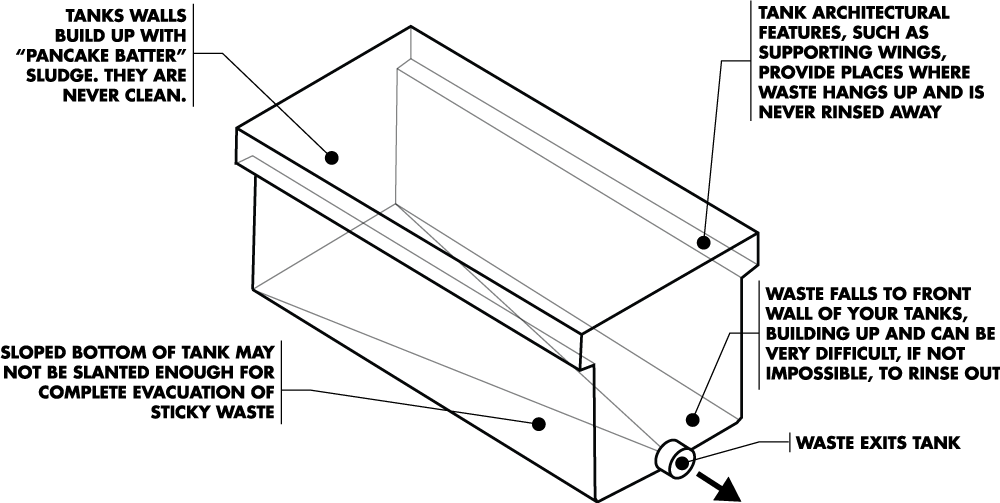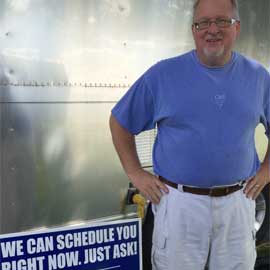RV holding tanks: What’s going on inside, exactly?
Holding tanks. They’re a mystery sometimes. What’s going on in there? What should you be concerned about? Is there anything you could be doing that you’re not? We’ll discuss what’s happening in your RV’s holding tanks, what ***should*** be happening, and why you may have some things to worry about.
If there’s one thing on RVs that we’ve almost seen couples come to fisticuffs on, it’s their holding tanks. We think we know what’s going on in there and yet there’s a lot of frustration surrounding them. So let’s get to the bottom of it. What’s really going on inside those things?
What is a holding tank?
![]()
Well, as you might guess, it’s a box. A large, plastic box in almost every case (some older ones were made of metal). Rectangular in shape, they tend to either be cube-like or long, flat, and not very deep. Both types have angled bottoms that tip toward the front. That’s how waste and water flows out.

Almost all RV plumbing systems dump into holding tanks from the top. In the best of cases, waste and water comes straight down and goes into the tank, but in most cases, there’s some bends and runs in the RV waste system plumbing.
At the front of the holding tank, a large, 3-inch or 1-1/2″ (black tank vs. gray tank) hole is drilled. This is how waste gets out of the tank when the valve is pulled to empty the tank. Tanks empty themselves using gravity (i.e. waste and water flow “down hill” out of the tank and into the flexible sewer hose, then out into the RV park’s sewer system).
Your tanks are for holding, not composting
![]()
As we’ve said before, your RV’s holding tanks are not a septic system. They were not intended to hold a mass of water waste and allow it to break down. In fact, by adding tank additives that contain harsh chemicals, enzymes, or biologicals, you’re just making things worse in your holding tanks. Why?
Those additives are doing exactly what they are intended to do: break down waste in your tanks. But, they’re breaking it down into a thick, sticky slurry that has a hard time flowing out of the tank. Plus, that sticky mess is making your tank sensors misread. And it never truly all comes out, unless you have your tanks professionally cleaned by Kleen Tank.
So what do you do?
![]()
There are some “best practices” to follow when caring for your RV’s holding tanks:
- Stop using tank additives, especially those that contain harsh chemicals, enzymes, or biologicals. If you really want to use something in your tank to improve flow and keep odors at bay, our homemade solution works well and is very affordable.
- Dump your holding tanks when they are 90% to 100% full. If you have to dump them before they are full, add fresh, clean water to raise the level in the tanks.
- Use a product like the Valterra Flush King Back Flush Valve. It’s a great way to really flush out holding tanks and get them clean. Plus, they flood your holding tanks faster than your in-tank system for your black tank and you can use it on both black and gray tanks!
- Once your tanks are empty, be sure to “prime the system” in each tank by adding three to five gallons (depending on your holding tank’s capacity) to give a base of clean water to start out with. It’s also good to add the same amount of clean water to your holding tanks when you are traveling with our RV.
Get your tanks professionally cleaned on a regular basis
![]()
Only hydrojetting by a professional tank cleaning service can truly get your holding tanks “factory clean.”
We recommend that full-time RVers get their holding tanks professionally cleaned twice a year by Kleen Tank. If you’d like to get a FREE quote, click here, or you can see if we’ll be at a rally that you’re attending this year.

Jim Tome, Owner
Hi, I'm Jim Tome and, along with my wife, Debbie, the owners of Kleen Tank LLC, the national leader in RV holding tank cleaning service. We've been RVers like you since 2004 and have traveled all over the U.S. in our Airstream travel trailer. We started the business about twelve years ago and have cleaned tens of thousands holding tanks in thousands of RVs. From tiny weekend travel trailers to monstrous fifth wheels to luxurious motorhomes, I've seen just about every situation there is with RV holding tanks and waste systems. I hope you enjoy our articles; I try to post at least one per week and we've got a great library of them to cover just about every problem. Enjoy!
Keep in mind that we may receive commissions when you click our links and make purchases. However, this does not impact our reviews and comparisons. We try our best to keep things fair and balanced, in order to help you make the best choice for you.
MAKE A QUICK INQUIRY
WE'LL GET RIGHT BACK TO YOU
WE'RE HERE FOR YOU
CONNECT WITH US
P.O. Box 313, Sycamore, IL 60178
844-KLEENME (844-553-3663)
info@KleenTank.com
Facebook.com/KleenTank
Instagram.com/KleenTank
WHAT DOES OUR SERVICE DO?
IT'S PRETTY SIMPLE...
Fixes and corrects your RV's tank sensors almost every time.
Features innovative, hydrojetting technology.
Is a 100% mobile service. We come to you at your site.
Is environmentally safe and makes no mess at your site.
Is chemical-free and all-natural.

0 Comments